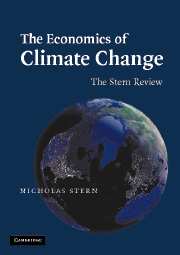Book contents
- Frontmatter
- Contents
- Preface
- Acknowledgements
- Introduction
- Summary of Conclusions
- Part I Climate Change – Our Approach
- Part II Impacts of Climate Change on Growth and Development
- Part III The Economics of Stabilisation
- 7 Projecting the Growth of Greenhouse-Gas Emissions
- 7A Climate Change and the Environmental Kuznets Curve
- 8 The Challenge of Stabilisation
- 9 Identifying the Costs of Mitigation
- 10 Macroeconomic Models of Costs
- 11 Structural Change and Competitiveness
- 11A Key Statistics for 123 UK Production Sectors
- 12 Opportunities and Wider Benefits from Climate Policies
- 13 Towards a Goal for Climate-Change Policy
- Part IV Policy Responses for Mitigation
- Part V Policy Responses for Adaptation
- Part VI International Collective Action
- Abbreviations and Acronyms
- Postscript
- Technical Annex to Postscript
- Index
8 - The Challenge of Stabilisation
Published online by Cambridge University Press: 05 March 2014
- Frontmatter
- Contents
- Preface
- Acknowledgements
- Introduction
- Summary of Conclusions
- Part I Climate Change – Our Approach
- Part II Impacts of Climate Change on Growth and Development
- Part III The Economics of Stabilisation
- 7 Projecting the Growth of Greenhouse-Gas Emissions
- 7A Climate Change and the Environmental Kuznets Curve
- 8 The Challenge of Stabilisation
- 9 Identifying the Costs of Mitigation
- 10 Macroeconomic Models of Costs
- 11 Structural Change and Competitiveness
- 11A Key Statistics for 123 UK Production Sectors
- 12 Opportunities and Wider Benefits from Climate Policies
- 13 Towards a Goal for Climate-Change Policy
- Part IV Policy Responses for Mitigation
- Part V Policy Responses for Adaptation
- Part VI International Collective Action
- Abbreviations and Acronyms
- Postscript
- Technical Annex to Postscript
- Index
Summary
KEY MESSAGES
The world is already irrevocably committed to further climate changes, which will lead to adverse impacts in many areas. Global temperatures, and therefore the severity of impacts, will continue to rise unless the stock of greenhouse gases is stabilised. Urgent action is now required to prevent temperatures rising to even higher levels, lowering the risks of impacts that could otherwise seriously threaten lives and livelihoods worldwide.
Stabilisation – at whatever level – requires that annual emissions be brought down to the level that balances the Earth's natural capacity to remove greenhouse gases from the atmosphere. In the long term, global emissions will need to be reduced to less than 5 GtCO2e, over 80% below current annual emissions, to maintain stabilisation. The longer emissions remain above the level of natural absorption, the higher the final stabilisation level will be.
Stabilisation cannot be achieved without global action to reduce emissions.Early action to stabilise this stock at a relatively low level will avoid the risk and cost of bigger cuts later. The longer action is delayed, the harder it will become.
Stabilising at or below 550 ppm CO2e (around 440–500 ppm CO2 only) would require global emissions to peak in the next 10–20 years, and then fall at a rate of at least 1–3% per year. By 2050, global emissions would need to be around 25% below current levels. These cuts will have to be made in the context of a world economy in 2050 that may be three to four times larger than today – so emissions per unit of GDP would need to be just one quarter of current levels by 2050.
- Type
- Chapter
- Information
- The Economics of Climate ChangeThe Stern Review, pp. 218 - 237Publisher: Cambridge University PressPrint publication year: 2007



